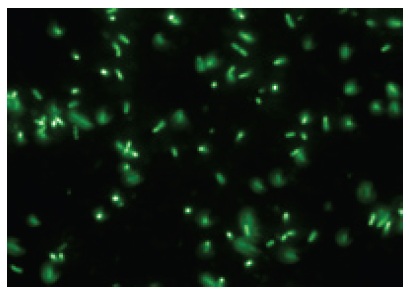-Bacstain- AO solution

Bacterial Staining
-
Product codeBS05 -Bacstain- AO solution
-
CAS No.65-61-2(AO)
-
Chemical name3,6-Bis(dimethylamino)acridine hydrOchloride, solution
-
MWC17H20ClN3=301.81
| Unit size | Price | Item Code |
|---|---|---|
| 100 assays | Find your distributors | BS05-10 |
Required Equipment and Materials
10 μl, 1000 μl pipettes, incubator, Microscope (blue excitation filter and red emission filter) or flow cytometer (488 nm blue laser)

Fig. 1 Cell staining mechanism
Manual
Technical info
1. Allow AO solutiona) to stand at room temperature for 30 minutes to thaw. Solution should be protected from light.
2. Resuspend the organisms with PBS(-) or saline and adjust the number of cells to 106 cells/mL(flow cytometry) or 108-109 cells/mL(microscopy).
3. Add 3 μl of AO solution into the 1 mL of microbial cell suspension and vortex gently to mix. Formaldehyde-fixation can be carried out if necessary.
4. Incubate the microbial cells at room temperature for 5 minutes.
5. Analyze the stained-cells with a flow cytometer or a microscope. The maximum wavelengths of the dye with ssDNA are 420-460 nm for excitation and 630-650 nm for emission. The maximum wavelengths of the dye with dsDNA are 500 nm for excitation and 520 nm for emission.
a) Since AO may be carcinogenic, be careful when handling and disposing.
Staining Data

Fig. 2 B. subtils stained with AO.
References
1) J. E. Hobbie et al., ” Use of Nucleopore Filters for Counting Bacteria by Fluorescence Microscopy”, Appl. Environ. Microbiol., 1977, 1225.
2) S. F. Nishino, “Direct Acridine Orange Counting of Bacteria Preserved with Acidified Lugol Iodine”, Appl. Environ. Microbiol., 1986, 602.
Handling and storage condition
| Appearance: | Yellow to orange liquid |
|---|---|
| Dye content: | To pass test |
| -20°C, Protect from light |











